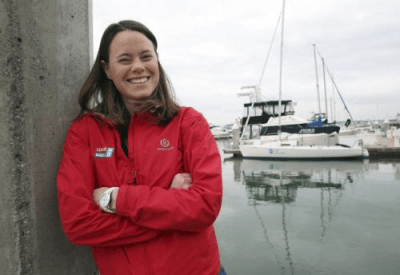Candidate Senior sailors need to own their own VHF radio. This guide is designed to give some basic orientation on what to look for when shopping for your first handheld VHF radio. This guide is not a generic guide but designed explicitly for use at the Cal Sailing Club, for brief recreational use on dinghies and keelboat cruises inside the bay area. You need a radio for basically two things: contacting the day leader and, in an extreme situation, contacting the Coast Guard. Senior skippers need to have a radio with them in order to sail outside of the Junior area, and will often use them when cruising with other Seniors.
Understand waterproof rating Most models are water proof and submersible, meaning they can be dropped into water and still be functioning when recovered. JIS4 means that the radio is barely splash resistant, JIS8 means the radio is submersible, it can stand for up to 30 minutes below 5' of water. Be careful when reading the descriptions when shopping because it's not uncommon to find JIS4 rated radios claimed as being 'waterproof'.
Floating or not? You want the radio primarily for your own safety, and you want to make sure it is securely attached to you at all times. It isn't going to help you if you leave it on a keelboat but fall off, or you lose it while sailing but don't realize it (a pretty likely occurrence if it isn't secured). For both dinghies and keelboats, assume that you'll end up in the water, so the radio has to be securely attached to you. CSC keelboats have a radio on board, so the portable one is for extra safety. The models that also float can be easier to recover in case they get detached from you but they can be slightly bulkier and more expensive. The extra cost of a floating one can be easily recovered the first time the radio drops in the water (which is not so unlikely, according to stories heard at the club).
Whether you decide to get a floating or non-floating model, make sure that the radio is securely tethered to your gear so that in a capsize it won't be ripped off of you. In general, do not rely just on the clip that attaches the radio to your life vest. In case you go for non-floating, you may want to get a waterproof case for it with enough buoyancy. You have to be careful, though, and take the radio out of the case when you're not using it otherwise the water (vapor) in the case can corrode the radio. The case needs to be securely attached to your life vest.
Power, screen, control and other features to look for 5 watt should be the minimum transmitting power. Rechargeable NiCad or Li-ion batteries are usually provided by the manufacturer, it's nice to have the possibility to put in regular AA batteries, too. Dual scan means that the radio will scan Channel 16 along with another Channel (69 for CSC). This is important because technically any boat under way is required to monitor Channel 16. Any boat carrying a VHF, whether required to or not, is required to monitor Channel 16. So when you're out the bay listening to our Channel 69, you have to also monitor Channel 16. The Dual Scan feature does this. Many VHFs have a triple scan feature, which monitors both Channel 16 and Channel 9 (the standard hailing channel). Squelch is widely used in two-way radios to suppress the annoying sound of channel noise when the radio is not receiving a transmission. Most handheld radios have a separate squelch control to set the threshold to the actual noise that's on the channel, which can vary. Control knobs to adjust volume are generally more usable than push buttons: think you may be wearing gloves or have your fingers slightly incapacitated when you really need to use the radio. If you carry the radio in a case, push buttons to control the radio volume can be better. Make sure that the screen is very visible also in daylight. Backlit displays are useful in low light. Some radios have water-activated lights that should make the radio much easier to locate in the event it goes in the water in low light conditions. A lock mode prevents the buttons to be operated when not needed.












